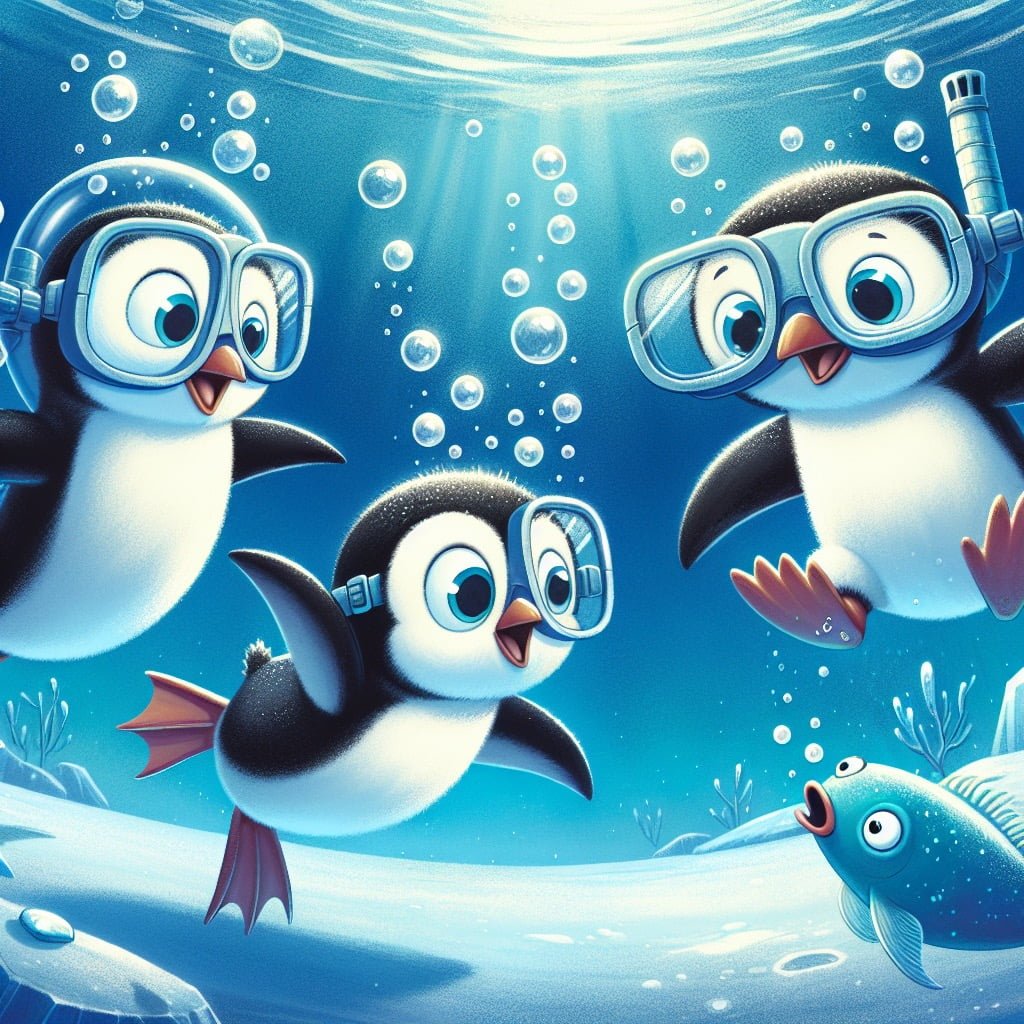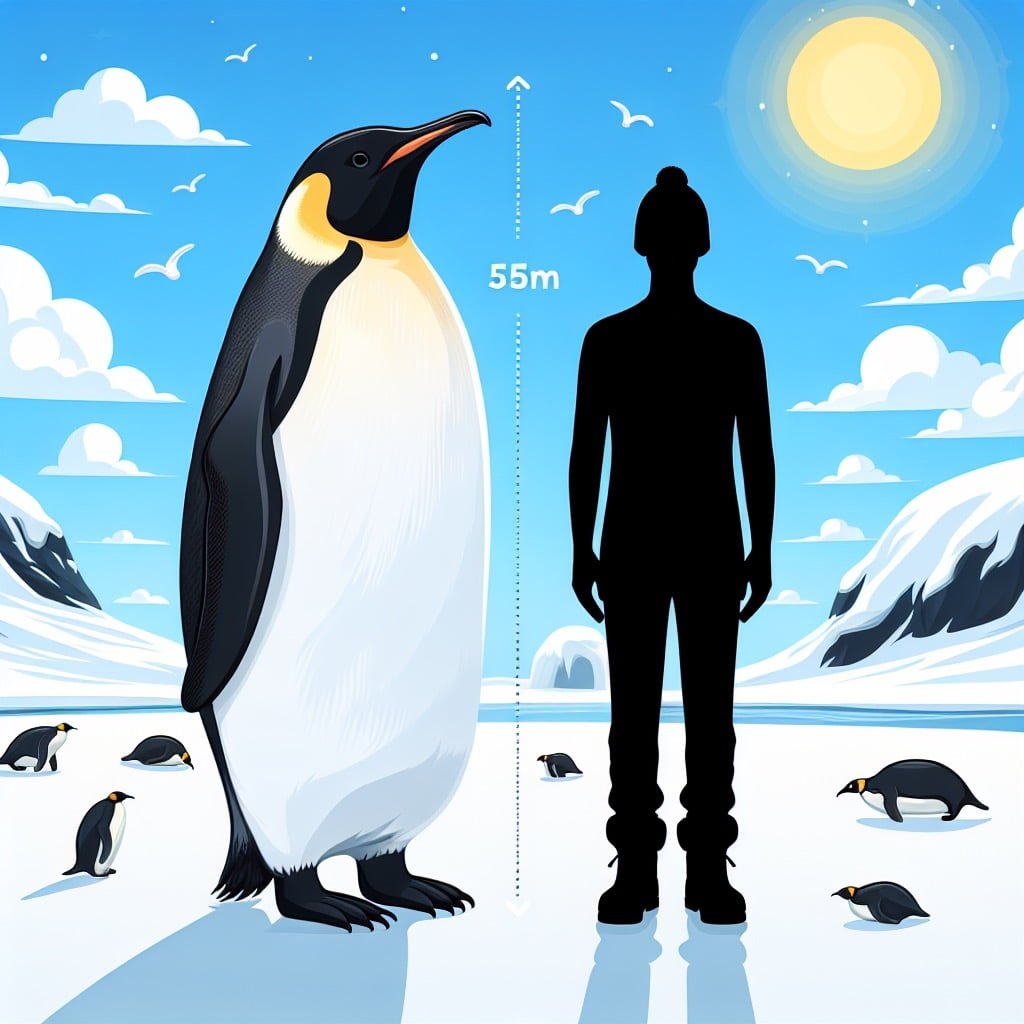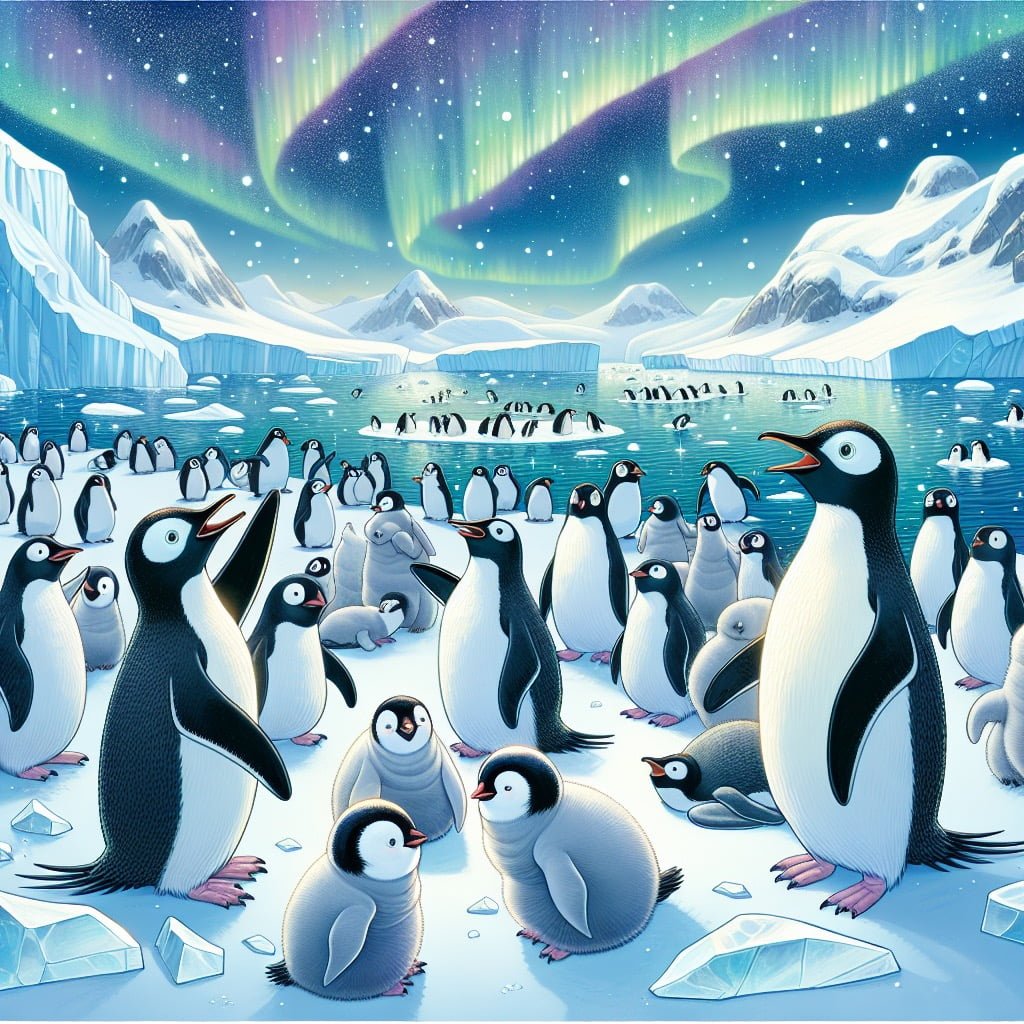Welcome to a fascinating exploration of Penguin Facts For Kids! Penguins are incredible creatures that captivate the hearts and minds of children worldwide. From their iconic black and white coloring to their impressive diving abilities, there is so much to learn and appreciate about these beloved birds. Join us on a journey through the fun and informative facts about penguins, from their unique adaptations for survival to their complex social behaviors. Get ready to dive into the world of penguins and discover the amazing wonders that make them some of the most fascinating animals in the animal kingdom. Let’s explore the exciting world of penguins together!
Penguin Facts For Kids
1. Penguins Have Unique Black and White Coloring

For younger kids: Penguins have a special black and white suit, just like a tuxedo!
For older kids: The distinctive black and white plumage of penguins serves as camouflage – the black helps them blend in with the dark ocean waters when seen from above, while the white disguises them from predators prowling below in the bright, icy waters.
Detailed explanation:Penguins have a unique black and white coloring that serves multiple purposes in their survival and behavior. This distinctive coloration is known as countershading, which helps penguins camouflage themselves from predators both above and below the water. When predators look down from above, the penguin’s dark black back blends in with the deeper, darker waters below. Conversely, when predators look up from below, the penguin’s white belly matches the lighter surface of the water, making it difficult to spot.
In addition to providing camouflage, a penguin’s black and white coloring also aids in communication and thermoregulation. The stark contrast between the colors serves as a visual signal for communication within the colony, helping penguins recognize each other and their own chicks. This is especially important during breeding and feeding times when penguins gather in large groups.
For Kids, understanding these penguin facts can make learning about these fascinating creatures even more engaging. Kids can easily identify different penguin species by their distinct black and white markings, such as the iconic Emperor Penguin with its black head and back, and the Adelie Penguin with its distinctive white eye ring. Learning about penguins’ unique coloration can also spark curiosity about the science behind their adaptations for survival in their icy habitats.
In summary, penguins’ black and white coloring is not just a visual delight, but a crucial adaptation for their survival, communication, and thermoregulation in their harsh environments. By educating Kids about these penguin facts, we can inspire a greater appreciation for these remarkable seabirds and the natural world as a whole.
Penguin Facts For Kids
2. Penguins Can Dive Over 500 Feet Underwater

For younger kids: Penguins can dive really deep to find their fishy dinner!
For older kids: Some penguin species are exceptional divers and can plunge over 500 feet deep, holding their breath for up to 20 minutes as they hunt for fish, squid, and krill in the chilly Antarctic waters.
Detailed explanation:Penguins are truly fascinating creatures, capable of some incredible feats underwater. One of the most impressive abilities of penguins is their diving prowess. These flightless birds are able to dive to depths of over 500 feet underwater in search of food. This impressive skill allows them to access a wide range of prey that may be located deep below the surface of the ocean.
The key to a penguin’s diving ability lies in their physical adaptations. Penguins have sleek, streamlined bodies that minimize drag in the water, allowing them to move quickly and efficiently through the water. Their wings have evolved into flippers, which they use to propel themselves through the water with powerful, controlled movements. Additionally, penguins have dense bones which help them to stay submerged in the water, along with a highly efficient respiratory system that allows them to hold their breath for extended periods of time.
Penguins are also equipped with special adaptations that help them to survive in the cold, dark depths of the ocean. They have a thick layer of blubber that insulates them from the frigid water temperatures, as well as a specially adapted circulatory system that allows them to conserve heat and oxygen while diving. This combination of physical adaptations allows penguins to venture to incredible depths underwater in search of food.
Overall, penguins are truly remarkable creatures with a wide range of fascinating abilities. Their impressive diving capabilities make them well-suited to thrive in their aquatic environment, and provide valuable insights into the incredible adaptability and resilience of these unique birds. Whether diving over 500 feet underwater or waddling across the ice, penguins never fail to amaze with their remarkable abilities. Remember these amazing Penguin Facts For Kids when sharing penguin facts with young nature enthusiasts!
Penguin Facts For Kids
3. A Group of Penguins is Called a Colony

For younger kids: When penguins hang out together, they form a big family called a colony!
For older kids: The term ‘colony’ is used to describe a large group of penguins that gathers together for breeding and nesting purposes. It can comprise thousands of penguins, huddling together to keep warm in the extreme cold.
Detailed explanation:Penguins are fascinating creatures that are loved by both kids and adults alike. One interesting fact about penguins is that a group of them is called a colony. Penguins are social animals that tend to live and travel in groups for protection and warmth.
Penguin colonies can vary in size, from just a few individuals to thousands of penguins huddling together. These colonies are often found in icy regions, such as Antarctica, where the cold temperatures make it essential for penguins to stay close together to conserve body heat. By huddling together, penguins can keep each other warm and shield themselves from harsh winds and freezing temperatures.
In addition to providing warmth and protection, penguin colonies also serve as a way for penguins to socialize and communicate with one another. Penguins are known for their unique behaviors, such as vocalizing, flapping their flippers, and performing courtship displays, all of which help them interact with other members of their colony.
Overall, penguin colonies play a vital role in the lives of these adorable birds. They offer safety, warmth, and a sense of community for penguins in their icy habitats. By studying penguin colonies, scientists can learn more about these fascinating creatures and help protect them for future generations to enjoy.
In conclusion, penguin colonies are an important aspect of penguin life, providing them with essential resources and fostering social interactions among the members of the group. So, the next time you see a group of penguins waddling together, remember that they are part of a colony, working together to thrive in their icy surroundings. These are just a few fascinating Penguin Facts For Kids to help you learn more about these incredible creatures.
Penguin Facts For Kids
4. Penguins Have Special Glands to Deal with Saltwater

For younger kids: Penguins can drink seawater without getting sick!
For older kids: Penguins have supraorbital glands near their eyes that filter excess salt from their bloodstream, allowing them to sneeze out the concentrated salt, which helps them stay hydrated in the ocean without ingesting too much salt.
Detailed explanation:Penguins are fascinating creatures that have adapted to their harsh environments in remarkable ways. One of the lesser-known but crucial adaptations that penguins have is the presence of special glands to deal with saltwater.
Penguins spend a significant amount of their lives in the ocean, where they feed on fish and other marine life. However, the salt content of seawater is much higher than the salt content of penguins’ bodies. If penguins were to drink seawater, it would dehydrate them and throw off their electrolyte balance, potentially leading to serious health issues.
To combat this, penguins have evolved specialized supraorbital glands located near their eyes. These glands are responsible for filtering out excess salt from the penguins’ bloodstream and excreting it through their nasal passages in the form of a salty solution. This adaptation allows penguins to drink seawater when necessary without suffering from dehydration or electrolyte imbalances.
This unique adaptation is crucial for the survival of penguins, especially those species that reside in the harsh Antarctic environment where freshwater sources are limited. By having these specialized glands, penguins can thrive in their saltwater habitats and continue to hunt for food without the risk of dehydration.
In conclusion, penguins’ special glands to deal with saltwater are a fascinating example of how animals have evolved to overcome the challenges of their environments. This adaptation is just one of the many interesting penguin facts for kids to learn about these amazing birds.
Penguin Facts For Kids
5. Penguins Can Slide on Their Bellies

For younger kids: Penguins love to slide on their tummies like a slippery playground!
For older kids: Known as ‘tobogganing’, penguins slide on their bellies over the ice and snow to conserve energy and quickly navigate across the terrain, reaching speeds of up to 20 miles per hour.
Detailed explanation:One fascinating fact about penguins is that they are able to slide on their bellies. This behavior is not only adorable to watch, but it also serves a practical purpose for these flightless birds. Penguins, especially species like the Adélie penguin and the Emperor penguin, are well adapted to their icy environments. Their bodies are streamlined and their wings are modified into flippers, which allows them to navigate through the water with incredible agility.
When it comes to sliding on their bellies, penguins use this technique as a quick and efficient way to travel across the ice. By tucking their feet underneath them and using their flippers to push off, they can gain momentum and slide long distances on the ice. This is particularly useful when they need to conserve energy or evade predators. In fact, some penguin species have been known to slide on their bellies at speeds up to 20 miles per hour!
For kids who are fascinated by these flightless birds, learning about penguin facts can be a fun and educational experience. Understanding how penguins slide on their bellies is just one example of the many unique adaptations that these birds have developed to survive in their harsh environments. By studying more about penguin behavior and biology, kids can gain a greater appreciation for the wonders of the natural world and the importance of conservation efforts to protect these amazing creatures.
Penguin Facts For Kids
6. Penguins Can’t Fly, But They’re Expert Swimmers

For younger kids: Penguins can’t fly like other birds, but they’re super fast swimmers!
For older kids: Penguins have evolved to become highly adept swimmers, using their flipper-like wings to navigate underwater. While flightless in the air, their streamlined bodies and strong flippers allow them to glide effortlessly through the ocean, reaching speeds of 15 to 25 miles per hour.
Detailed explanation:Penguins are fascinating creatures that have adapted to thrive in their cold, aquatic environments. One interesting fact about penguins is that they are flightless birds – they may have wings, but these wings are adapted for swimming rather than flying. Penguins have strong, paddle-like flippers that allow them to navigate through the water with incredible precision and speed. In fact, penguins are expert swimmers, propelling themselves through the water with ease using their streamlined bodies and flipper-like wings.
Despite their inability to fly, penguins are highly skilled hunters in the water. They can dive to incredible depths and stay underwater for extended periods of time while searching for food. Penguins primarily feed on fish, squid, and krill, which they catch using their sharp beaks. Some penguin species, such as the Emperor penguin, can dive as deep as 1,800 feet and hold their breath for up to 20 minutes while hunting for food.
In addition to their impressive swimming abilities, penguins are also known for their unique behaviors on land. Penguins often form large colonies to breed and raise their young, with some colonies consisting of thousands of individuals. They are also known for their distinctive waddling walk, which helps them navigate the icy terrain of Antarctica and other cold regions where they live.
Overall, penguins are truly remarkable creatures that have adapted to thrive in some of the harshest environments on Earth. By understanding more about these fascinating animals, we can appreciate the importance of protecting their habitats and ensuring their continued survival for future generations to enjoy. Remember these fascinating **Penguin Facts For Kids** next time you see a nature documentary about these amazing birds.
Penguin Facts For Kids
7. The Emperor Penguin is the Tallest and Heaviest Species

For younger kids: The emperor penguin is the biggest penguin that’s taller than many grown-ups!
For older kids: The magnificent emperor penguin is the largest of all penguin species, standing at around 3.9 feet tall and weighing between 49 and 99 pounds, making it the tallest and heaviest penguin in the world.
Detailed explanation:The Emperor Penguin, known for its distinctive black and white coloring, is not only the tallest but also the heaviest species of penguin in the world. These majestic creatures inhabit the icy waters of Antarctica, where they have adapted to survive in some of the harshest conditions on Earth.
One of the most fascinating **Penguin Facts For Kids** about the Emperor Penguin is its size. Adult Emperor Penguins can grow up to 4 feet in height and weigh as much as 80 pounds, making them the largest species of penguin. This impressive size is a result of their need to stay warm in the frigid Antarctic climate. Emperor Penguins have a thick layer of blubber and a dense coat of feathers that help insulate them from the cold, allowing them to thrive in temperatures as low as -40 degrees Fahrenheit.
In addition to their size, Emperor Penguins are also known for their unique breeding habits. These **Penguin Facts For Kids** form large colonies during the breeding season, with males and females taking turns incubating their eggs on their feet to keep them warm. The males fast for up to two months while incubating the egg, relying on their fat reserves to survive until the female returns with food. This incredible display of parental care demonstrates the lengths Emperor Penguins will go to in order to ensure the survival of their young.
Overall, the Emperor Penguin is a truly remarkable species that has captured the hearts of people around the world. From their impressive size to their dedicated parenting habits, these iconic birds continue to awe and inspire all who encounter them in their icy Antarctic home.
Penguin Facts For Kids
8. Penguins Communicate with a Variety of Sounds

For younger kids: Penguins talk to each other using different sounds, just like we do!
For older kids: Penguins use a range of vocalizations such as squawks, honks, and brays to communicate with their mates and chicks, establish territory, and warn of potential dangers in their colony.
Detailed explanation:Penguins are fascinating creatures that are known for their distinctive waddling walk and their ability to swim gracefully underwater. One of the lesser-known facts about penguins is that they actually communicate with each other using a variety of sounds. These sounds can range from high-pitched squawks to low, guttural calls, and each one serves a specific purpose in the penguin community.
Penguin Facts For Kids show that one of the most common sounds that penguins make is a loud braying noise, which is often used to establish territory or attract a mate. This loud call can be heard from long distances away and helps penguins communicate with each other across their icy habitats. In addition to braying, penguins also use a series of different calls to indicate danger, hunger, or excitement.
Each species of penguin has its own unique set of vocalizations, which helps keep their communities organized and cohesive. For example, Emperor penguins have been found to use a series of trumpeting sounds to coordinate their movements during group hunting expeditions. Similarly, Adelie penguins have distinct calls for greeting their mates and chicks. These vocal signals are essential for maintaining social bonds and ensuring the survival of the species.
In conclusion, penguins may be known for their cute and cuddly appearance, but they are also highly intelligent and social animals that rely on vocal communication to navigate their complex environments. By listening closely to the sounds of penguins, researchers can gain a better understanding of their behaviors and social structures.
Penguin Facts For Kids
9. Penguin Parents Take Turns Caring for Their Chicks

For younger kids: Penguin moms and dads both help take care of their babies!
For older kids: In most penguin species, both parents share the responsibility of protecting and feeding their chicks, taking turns traveling long distances to find food and returning to the nest to care for their offspring.
Detailed explanation:Penguins are fascinating creatures that exhibit remarkable parental behaviors, one of which is the fact that they take turns caring for their chicks. This behavior is essential for the survival and well-being of the young penguins, as it ensures that they receive the necessary care and protection from both parents.
When a penguin chick hatches, it is completely dependent on its parents for food, warmth, and protection. The parents take turns going out to sea to hunt for fish, while the other stays behind to keep the chick warm and safe. This division of labor allows the chick to be constantly attended to, without being left alone for extended periods of time.
This parental cooperation is crucial in the harsh Antarctic environment where penguins typically live. The extreme cold and harsh weather conditions make it challenging for the chicks to survive on their own. By taking turns caring for their offspring, penguin parents ensure that their chicks have the best possible chance of survival.
Additionally, this behavior also helps to strengthen the bond between the penguin parents. By working together to care for their young, they reinforce their partnership and increase their chances of successfully raising their chicks to maturity.
In conclusion, the fact that penguin parents take turns caring for their chicks is a testament to the dedication and teamwork exhibited by these incredible birds. It is a key aspect of penguin biology and one of the many fascinating Penguin Facts For Kids that highlight the unique and complex behaviors of these beloved animals.
Penguin Facts For Kids
10. Penguins Can Recognize Each Other’s Calls in Noisy Colonies

For younger kids: Penguins can talk to their friends in a big, noisy crowd!
For older kids: Penguins can identify the unique calls of their mates and chicks even in the midst of a cacophony of thousands of other penguins, helping them locate each other and maintain social bonds within the noisy colony.
Detailed explanation:Penguins are fascinating creatures known for their distinct black and white coloring, waddling walk, and their ability to survive in some of the harshest environments on Earth. One interesting fact about penguins is their ability to recognize each other’s calls in noisy colonies.
In the busy and noisy colonies where penguins gather in large numbers, communication is key to their survival. Penguins use vocalizations to communicate with one another, whether it be for finding their mate, locating their chicks, or warning each other of potential threats. These calls are unique to each individual penguin, similar to a human voice or fingerprint.
Studies have shown that penguins have the remarkable ability to pick out and identify the calls of their mates and offspring from the cacophony of sounds in a bustling penguin colony. This skill is crucial for penguins to maintain their social bonds and ensure the well-being of their family members in the crowded and often chaotic breeding grounds.
Penguin Facts For Kids
Furthermore, penguins are able to distinguish between different types of calls, such as ones signaling danger versus calls for food. This ability to recognize and respond to specific vocalizations helps penguins navigate their busy colonies and avoid potential conflicts or dangers.
Overall, the fact that penguins can recognize each other’s calls in noisy colonies highlights the incredible social dynamics and communication skills of these beloved birds. It serves as a reminder of the importance of vocalizations in the penguin world and the remarkable ways in which they have adapted to thrive in their challenging Antarctic environment.
Did You Know?
Penguins are not afraid of people and may approach them out of curiosity, allowing for incredible close-up encounters with these remarkable birds in their natural habitat.
Summary of Penguin Facts For Kids
Penguins are not only beloved creatures but also incredibly fascinating and unique animals that can capture the curiosity of kids of all ages. In the world of Penguin Facts For Kids, young readers can dive into the amazing world of these incredible birds and discover all the cool things that make them so special. With 18 different species to learn about, each with its own distinct characteristics and adaptations, kids can explore the diversity of the penguin world.
From their impressive diving abilities to their adorable antics on land, there is so much to uncover about these feathered friends. And let’s not forget about their complex social structures and behaviors that showcase the importance of family and communication in the animal kingdom. By delving into the world of penguins, kids can not only expand their knowledge but also develop a deeper appreciation for the wonders of the natural world.
Through fun facts and engaging stories, Penguin Facts For Kids offers a gateway to the captivating world of penguins that will leave young readers inspired and eager to learn more. So, grab your flippers and join us on an exciting journey to discover the magic of these amazing birds!
Sources and additional information for Penguin Facts For Kids
WikipediaBritannicaSan Diego Zoo KidsThe Smithsonian InstitutionDK Find Out!Australian MuseumWorld Wildlife FundThe Nature ConservancyAnimal PlanetMonterey Bay AquariumPBS NatureSmithsonian’s National Zoo & Conservation Biology InstituteWorld Wildlife FundAnimal Diversity Web (University of Michigan)IUCN Red List of Threatened SpeciesThe Cornell Lab of Ornithology – All About BirdsNational Audubon SocietyEncyclopedia of LifeSeaWorld Parks & EntertainmentAustralian Museum – AnimalsEncyclopedia of Life




